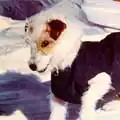Bothie (dog)
Bothie, also known as Bothie the Polar Dog, was a long-haired Jack Russell Terrier who was the only dog to travel to both the South and North Poles. Bothie was owned by Ranulph Fiennes and Ginny Fiennes and accompanied the team on the circumpolar Transglobe Expedition from 1979 to 1982.
 | |
| Species | Dog |
|---|---|
| Breed | Jack Russell Terrier |
| Sex | Male |
| Occupation | Polar explorer |
| Owner | Ranulph Fiennes and Ginny Fiennes |
Expedition
The Transglobe Expedition (1979–1982) was the first successful longitudinal (north–south) circumnavigation of the Earth using only surface transport, traversing both the South and North Poles.[1][2] The expedition was conceived by Ginny Fiennes and led by her husband Ranulph Fiennes.[3]
Bothie, a stray long-haired brown-and-white Jack Russell Terrier, was given to the Fiennes couple in 1977, two years before the expedition.[4][5] He was flown to join the Transglobe crew following the Africa segment, which was considered too hot for him.[6]
Bothie accompanied Ginny Fiennes throughout the rest of the expedition. This included enduring an Antarctic winter during his nine-month stay on the continent, and spending six weeks at the pole. During this period Bothie participated in the first cricket match ever held at the South Pole.[7] To help him with the cold temperatures Bothie was kitted with tailor-made red coat, balaclava facemask, and boots, though he was said to consider these as "seldom needed".[8][9]
From Antarctica the team sailed north on the MV Benjamin Bowring to Canada.[10] After travelling through the Northwest Passage Ranulph Fiennes and Charles Burton made the trip to the North Pole by powered sledges arriving 10 April 1982, before signalling to base camp that they had arrived. To celebrate their achievement, a Twin Otter aircraft was sent out to deliver the two men supplies, including champagne, as well as Bothie.[11] At this point Bothie became the first dog to ever "set paw on both the South and North poles".[2][12][5]
During the three-year expedition, Bothie was considered by members of the team as "a friend and welcome distraction to everyone", bringing a "sense of home and normality" to the venture.[13][5]
Return
Upon return to Great Britain, following a six-month anti-rabies quarantine, Bothie achieved a level of celebrity including featuring on the Blue Peter TV programme, being voted Great Britain's Pet of the Year and presented a prize at Crufts in 1983, inspiring a soft-toy range, and entry into the Guinness Book of Pet Records.[5][14][15] In 1984, Ranulph and Ginny Fiennes released a best-selling[12] book on his adventures called Bothie The Polar Dog.[16]
Following his return, Bothie retired from polar exploration aged 7 years.[5]
Legacy
No other canine is expected to match Bothie's achievement of visiting both poles after the Antarctic Treaty of 1994, which has subsequently forbidden dogs from the Antarctic continent to protect the native seal population.[14][17]
See also
References
- Fiennes, Ranulph (1983). To the Ends of the Earth : The Transglobe Expedition, the First Pole-to Pole Circumnavigation of the Globe. Gage Learning. ISBN 978-0877956143.
- Dimery, Rob (18 August 2015). "1982: First Surface Circumnavigation via both Geographical Poles". Guinness World Records. Archived from the original on 18 October 2022. Retrieved 18 October 2022.
- Shepard, Oliver (24 February 2004). "Virginia Fiennes". The Guardian. Archived from the original on 18 October 2022. Retrieved 2 October 2022.
- Marsh, Carl (12 November 2019). ""I went from 15½ stone to nine at the halfway point, despite eating 5,000 calories a day!" – SIR RANULPH FIENNES INTERVIEW". BuzzMag. Archived from the original on 18 October 2022. Retrieved 18 October 2022.
- "Made 50,000-Mile Journey With Expedition : Bothie, the Only Dog to Visit Both Poles". Los Angeles Times. 6 January 1985. Archived from the original on 15 October 2022. Retrieved 16 October 2022.
- "The Very Good Adventure Dogs of History". Outside Online. 3 June 2019. Archived from the original on 18 October 2022. Retrieved 18 October 2022.
- Cryer, Max (2013). Every Dog Has Its Day A Thousand Things You Didn't Know about Man's Best Friend. Exisle Publishing. ISBN 9781921966286. Archived from the original on 22 April 2023. Retrieved 2 November 2022.
- "Bothy at Ryvingen in his polar gear (seldom needed and despised by him)". Freeze Frame — Scott Polar Research Institute. Archived from the original on 26 October 2022. Retrieved 26 October 2022.
- Preston, Alex (24 August 2019). "Pole to Pole: the story behind Sir Ranulph Fiennes' pioneering circumpolar expedition - told 40 years on". Daily Telegraph. Archived from the original on 16 October 2022. Retrieved 16 October 2022.
- "The Ship: M.V. Benjamin Bowring". Transglobe Expedition. Archived from the original on 29 November 2022. Retrieved 29 November 2022.
- "Part 3: The Arctic May 1981 – August 1982". Transglobe Expedition. Archived from the original on 25 October 2022. Retrieved 25 October 2022.
- "Her vision kept men at sea, on ice". Sydney Morning Herald. 27 February 2004. Archived from the original on 16 October 2022. Retrieved 16 October 2022.
- Fiennes, Ranulph. "Part 2: The Antarctic January 1980 – April 1981 Overwintering". Transglobe Expedition. Archived from the original on 25 October 2022. Retrieved 25 October 2022.
- Addison-Swan, Catherine (22 December 2021). "How one 'stubborn-minded' Jack Russell became the only dog to visit both the North and South Poles". Daily Mirror. Archived from the original on 16 October 2022. Retrieved 16 October 2022.
- Stall, Sam (2011). 100 Dogs Who Changed Civilization History's Most Influential Canines. Quirk Books. ISBN 9781594745874. Archived from the original on 22 April 2023. Retrieved 2 November 2022.
- Fiennes, Virginia; Fiennes, Ranulph (1984). Bothie the Polar Dog. Hodder and Stoughton. ISBN 0-340-36319-3.
- Macklin, Debbie (22 June 1991). "Redundant huskies sent packing from Antarctica". New Scientist. Archived from the original on 22 April 2023. Retrieved 29 October 2022.